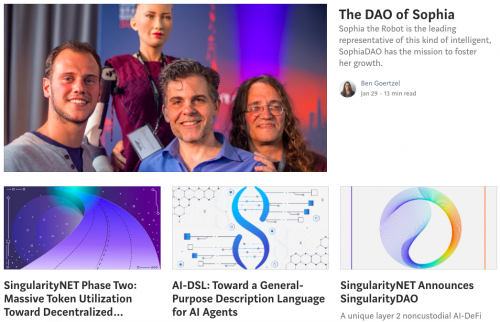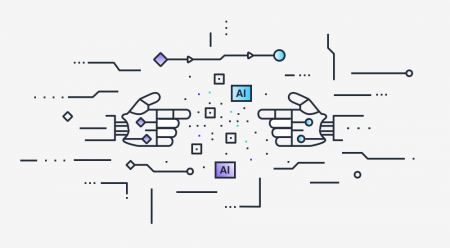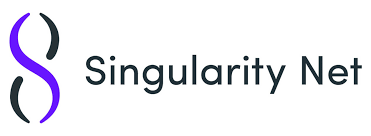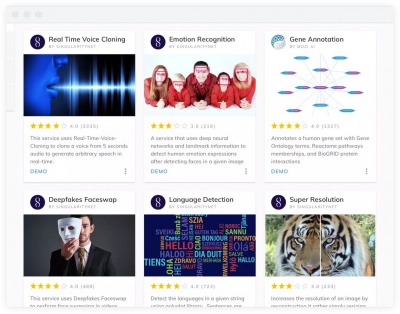Difference between revisions of "SingularityNet"
(→Decentralizing AI Services) |
(→Publishing) |
||
| Line 8: | Line 8: | ||
==Decentralizing AI Services== | ==Decentralizing AI Services== | ||
===Publishing=== | ===Publishing=== | ||
| − | The publishing process on SingularityNet is structured in a way that any individual or group with an internet connection can establish an Ethereum identity (soon to be a Cardano identity)<ref name = "Cardano SingularityNet proposal explanation">SingularityNet (2021). [https://blog.singularitynet.io/singularitynet-phase-two-massive-token-utilization-toward-decentralized-beneficial-agi-6e3ac5a5b44a]. ''Cardano and SingularityNet proposal explanation''. Retrieved Mar 26, 2021. </ref> and link their computers as a cluster to begin working on the creation of AI “agents” – another way of saying semi-autonomous machine learning algorithm. | + | The publishing process on SingularityNet is structured in a way that any individual or group with an internet connection can establish an Ethereum identity (soon to be a Cardano identity)<ref name = "Cardano SingularityNet proposal explanation">SingularityNet (2021). [https://blog.singularitynet.io/singularitynet-phase-two-massive-token-utilization-toward-decentralized-beneficial-agi-6e3ac5a5b44a]. ''Cardano and SingularityNet proposal explanation''. Retrieved Mar 26, 2021. </ref> and link their computers as a cluster to begin working on the creation of AI “agents” – another way of saying semi-autonomous machine learning algorithm. To add new members to the organization or service, the owner simply needs to add the additional user's email address. Currently, using the Ethereum Ropsten testnet, a team or individual has plenty of room to toy with and tweak the AI before publishing to the SingularityNet open marketplace which runs on the Ethereum mainnet. But before their AI is published, it is checked by the SingularityNet team and then officially published onto the marketplace<ref name = "Introduction to the Publisher Portal">SingularityNet (2021). [https://dev.singularitynet.io/products/publisher/]. ''Introduction to the Publisher Portal''. Retrieved Apr 1, 2021. </ref>. In this testnet environment, they have access to faucets for testnet ETH and AGI, allowing them to fuel any tests necessary to confirm that their "agent" is prepared for the mainnet marketplace. Once polished, the individual or team releases their agent to the market, wherein its services are purchased for some set cost paid in AGI, which the individual or team then receives. |
===Marketplace=== | ===Marketplace=== | ||
Revision as of 20:30, 1 April 2021
SingularityNet provides a decentralized protocol and network on which AI services can cooperate, coordinate, and interoperate. It was founded by blockchain/AI entrepreneurs Ben Goertzel, David Hanson, and Simone Giacomelli. [1]. Due to its decentralized nature, anyone from around the world can take part in creating or utilizing an AI service, as well as staking the native token ($AGI) to facilitate marketplace operations and earn a reward. Critically, SingularityNet shifts the barrier of entry downwards for engaging in the world of research-grade artificial intelligence services. The SingularityNet community, blog, and YouTube channel all provide valuable perspectives on the development of decentralized services relating to AI, as well as some well-needed ‘big picture’ information for this period of technological change. Though still in its technical infancy, its theoretical potential has gained the attention of mainstream media outlets[2] and hackers alike.
Contents
Decentralizing AI Services
Publishing
The publishing process on SingularityNet is structured in a way that any individual or group with an internet connection can establish an Ethereum identity (soon to be a Cardano identity)[3] and link their computers as a cluster to begin working on the creation of AI “agents” – another way of saying semi-autonomous machine learning algorithm. To add new members to the organization or service, the owner simply needs to add the additional user's email address. Currently, using the Ethereum Ropsten testnet, a team or individual has plenty of room to toy with and tweak the AI before publishing to the SingularityNet open marketplace which runs on the Ethereum mainnet. But before their AI is published, it is checked by the SingularityNet team and then officially published onto the marketplace[4]. In this testnet environment, they have access to faucets for testnet ETH and AGI, allowing them to fuel any tests necessary to confirm that their "agent" is prepared for the mainnet marketplace. Once polished, the individual or team releases their agent to the market, wherein its services are purchased for some set cost paid in AGI, which the individual or team then receives.
Marketplace
The marketplace itself is something like a bazaar for AI/machine learning services. It lists the available AI services and helps users interact with those services through web interface, which helps display all details about the service quickly without relying on the slow Blockchain (The Blockchain is a system where a record of transactions made in a cryptocurrency are maintained across several linked computers)[5]. At the time of writing, the vast majority of the services are agents created by SingularityNet to provide cheap demos for the kinds of services that would be available once institutional adoption occurs. An example of the kinds of services currently available at the marketplace includes algorithms such as those that aid in colorizing and restoring black and white photographs, or another that helps to annotate and represent genetic data.
Native Token: AGI
The vast majority of blockchain protocols have a unit of value (a token) used to transact and serve as the backbone for other technical functions. For SingularityNet, this token is AGI[6]. The ticker is a play on words for the abbreviation of "artificial general intelligence", which is described as the precursor step to a technological, AI singularity. The AGI token serves a host of functions, foremost serving the unit of value when users and AI agents are performing transactions. As these agents go about performing on various other platforms, the AGI token serves as an anchor for settlement[6] when one agent ‘pings’ the use of various others. In addition, agents are required to stake[7] an amount of AGI tokens to go about performing on the network. This stake can be partially drained if their ranking drops below a certain level, thus incentivizing performance. AGI is also used by the community to fund the development of AI and machine learning services via the RFAI functionality.
Request For AI
Integral to the smooth functioning of the marketplace is the Request For AI[8] (RFAI) functionality. In essence, RFAI allows the community of developers and general token holders to create specific requests for well-defined services and to fund requests which have already been made using the AGI token. Once developers propose various solutions to some request, those who have funded the request will vote on which solution functions optimally, and the AGI which tokens used to fund the request will be distributed according to the voting distribution [8]. After the voting is ended and developers claim their proportion of the AGI tokens, the request is closed, though the solution can be made available by the developer in the marketplace.
SingularityNet Media and Community

Look no further than the SingularityNet blog or the SingularityNet Youtube channel to find all things artificial intelligence. The range of topics that these two locales of media have been able to cover in their relatively short existence (2018 and 2017, respectively) has created a hub for interested individuals and parties to explore and connect with relevant topics. As a rule, blockchain-based projects tend to evolve rapidly and make connections at the same pace as other relevant projects. This is true for any young business, but in the still-young world of blockchain, projects are constantly trying to find their space and coordinate with other relevant projects. SingularityNet has been a part of this trend, coordinating with projects such as Cadarno on the migration of the native token to the Cardano blockchain[3], and with NuNet, a decentralized computing platform[9]. SingularityNet does not only cover their partnerships and technical roadmap, the Youtube channel provides access to recorded excerpts of AGI conferences and even small talks from founder Ben Goertzel concerning books relevant to a world with artificial general intelligence. One such book review was about “Sand Talk”, by Tyson Yunkaporta, and discusses the ways of being and knowing which have been widely lost by our global and technological society.
In ensuring the future of these emerging technologies lies in the hands of people who are informed about broader the troubles of the world, these seemingly tangential discussions are worth their weight in gold for blockchain technology communities. Tech corporations raised under a classically centralized structure (i.e. Facebook, Google) have come to be a moral and social burden on society at large[10]. Though the social outreach of these corporations has been extreme and in many cases with positive intent, their inherent structure and bottom line tend to obfuscate the realization of their philanthropic social goals. The aims of SingularityNet providing mass access to media wherein professionals speak of decentralizing the institutions of health, finance, the economy, and even consciousness, will inform those closest to the cutting edge of a world less reliant on the massive corporations of the past two decades.
Ethical Implication
The ethical implications of AI development are vast, with many critics concerned with the potential widening of racial and socioeconomic inequality[11] in a world ever more reliant on big data, and with many others hopeful and excited for advancing domains of science and technology that could one day be used to help the populace. These perspectives shed light on a broad polarity of the issue of AI development, but with protocols such as SingularityNet harnessing the decentralized nature of blockchain technology, the view on AI ethics will undoubtedly shift frame (though not away from classical concerns) towards a world more reliant on decentralized AI services. The past two decades in the corporate realm have created bloated and massively powerful tech institutions hoarding data troves of mythical proportion. This, coupled with older, global institutions built upon outdated and imperfect axioms, has led the data processing of our highly networked society to skew towards maintaining ineffective, but profitable, cultural institutions which have taken a new form in the digital age[12].
However, with technology like SingularityNet, its political form skews inherently[14] towards democratizing the way value flows through data processing systems. In this way, as more and more people from around the world contribute their created ML/AI services to this open network, the systems and inventions cultivated from access to these tools will reflect more properly the interpretative mode of the populace. Interpretation[10] of data, models, and experiments is one of the factors which forces centralized, corporate entities to design and produce technological products which serve to further entrench the world within the status quo of data centralization. Decentralized systems, such as SingularityNet, aid in decentralizing the work of interpreting and creating models, aligning incentives further away from the centralized model of corporate governance we have seen over the past two decades with the likes of Facebook and Google.
See Also
- Artificial Agents
- Artificial Intelligence and Technology
- Algorithms
- Artificial Superintelligence
- Bias in Information
- Blockchain
- Data Brokers
- DNA Testing
- Racial Algorithmic Bias
References
- ↑ SingularityNet (2019). [1]. SingularityNet Whitepaper 2.0. Retrieved Mar 8, 2021.
- ↑ Damiani, Jesse (2017). [2]. AI Is The Future Of Computing, And SingularityNET Is The Future Of AI. Retrieved Mar 8, 2021.
- ↑ 3.0 3.1 SingularityNet (2021). [3]. Cardano and SingularityNet proposal explanation. Retrieved Mar 26, 2021.
- ↑ SingularityNet (2021). [4]. Introduction to the Publisher Portal. Retrieved Apr 1, 2021.
- ↑ SingularityNet (2021). [5]. Introduction to SingularityNET Marketplace. Retrieved Apr 1, 2021.
- ↑ 6.0 6.1 Mari, Marcello (2017). [6]. Exploring the Utility of SingularityNET’s AGI Token. Retrieved Mar 9, 2021.
- ↑ SingularityNet (2020). [7]. Why the AGI Token Needs Staking. Retrieved Mar 9, 2021.
- ↑ 8.0 8.1 SingularityNet (2020). [8]. Request for AI Service. Retrieved Mar 9, 2021.
- ↑ NuNet (2020). [9]. NuNet Whitepaper: A Global Economy of Decentralized Computing. Retrieved Mar 26, 2021.
- ↑ 10.0 10.1 Danah Boyd, Kate Crawford (2012). [10]. CRITICAL QUESTIONS FOR BIG DATA Provocations for a cultural, technological, and scholarly phenomenon. Retrieved Mar 9, 2021.
- ↑ O'Neil, Cathy (2016). Introduction. Retrieved Mar 12, 2021.
- ↑ Zittrain, Jonathan, Cathy (2009). [11]. The Internet Creates a New Kind of Sweatshop. Retrieved Mar 12, 2021.
- ↑ Khan, Arif (2019). [12]. A beginner’s guide to the SingularityNET Beta [UPDATED]. Retrieved Mar 12, 2021.
- ↑ Winner, Langdon (1980). [13]. Do Artifacts Have Politics?. Retrieved Mar 12, 2021.

